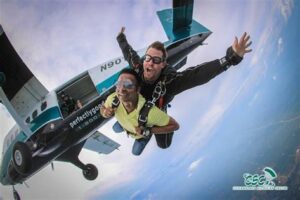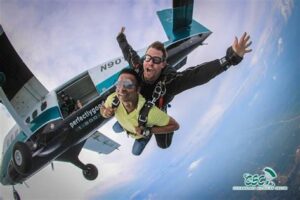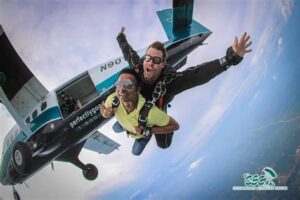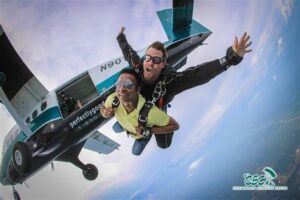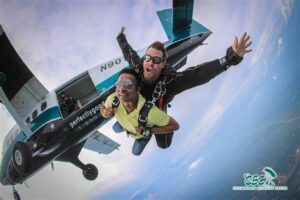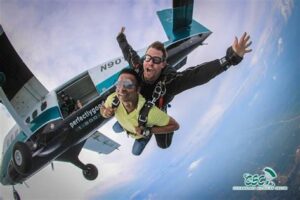Table of Contents
Curious about skydiving solo? Find out how many jumps it takes to achieve this thrilling milestone. Discover the necessary training, skills, and experience needed to embark on a solo skydiving adventure. Get ready to soar through the skies on your own terms!
Are you ready to take the leap and experience the thrill of skydiving solo? If you’re wondering how many jumps it takes to reach this exhilarating milestone, you’ve come to the right place. Transitioning from tandem jumps, where you are harnessed to an instructor, to jumping solo is a significant step in any skydiver’s journey. It requires a certain level of skill, knowledge, and confidence that can only be acquired through practice and experience. So, let’s delve into the world of solo skydiving and explore just how many jumps it typically takes to soar through the skies on your own.
Introduction
Skydiving is an exhilarating and adrenaline-pumping activity that attracts many thrill-seekers. Whether you are taking your first leap or have already experienced the thrill of tandem skydiving, the question of how many jumps are required to skydive solo often arises. In this article, we will explore the journey from novice to solo skydiver, discussing the steps and training involved in achieving this milestone.
The First Jump: Tandem Skydiving
What is Tandem Skydiving?
Tandem skydiving is the perfect starting point for beginners. During a tandem jump, you are securely harnessed to an experienced instructor who handles all aspects of the jump. This allows you to enjoy the experience without worrying about the technicalities of skydiving.
Why Start with Tandem Skydiving?
Tandem skydiving serves as an introduction to the sport, giving you a taste of the incredible rush that skydiving provides. It helps build confidence and allows you to experience freefall without the added responsibility of controlling the parachute and landing.
The Accelerated Freefall (AFF) Program
What is the AFF Program?
The Accelerated Freefall (AFF) program is the most common training method for individuals aiming to become solo skydivers. This program focuses on teaching you the necessary skills and techniques to skydive independently.
The Structure of the AFF Program
The AFF program typically consists of a series of jumps, each with specific objectives and skill requirements. These jumps are conducted under the supervision and guidance of qualified instructors who assess your progress throughout the program.
Progressing through the AFF Jumps
Jump 1: The First Solo Exit
After completing the tandem skydive, jump 1 of the AFF program marks your first solo exit from the aircraft. You will be accompanied by two instructors who maintain physical contact while assisting you in maintaining stability during freefall.
Jumps 2-7: Skill Development
During jumps 2 to 7, you will work on mastering essential skydiving skills such as body position, altitude awareness, stability, and deploying your own parachute. Each jump builds upon the previous one, gradually increasing your level of independence.
Jumps 8-9: Consolidation
Jumps 8 and 9 focus on consolidating the skills you have learned so far. During these jumps, you will demonstrate your ability to perform controlled turns, forward movement, and docking with other skydivers.
Jumps 10-25: Advanced Skills
Once you have successfully completed the initial jumps, you will progress to more advanced skills such as tracking, backflips, and turns. These jumps further enhance your flying abilities and prepare you for a future in skydiving.
Reaching Solo Status
Solo Certification Requirements
To obtain your solo skydiving certification, you must complete a minimum of 25 jumps, including all the required AFF jumps. Additionally, you need to pass written exams covering essential skydiving knowledge and demonstrate proficiency in various practical skills.
Continuing Education and Beyond
Once you achieve your solo status, the learning doesn’t stop. Many skydivers continue their education by pursuing additional courses and certifications, such as the USPA ‘A’ license, which allows them to participate in more advanced jumps and join group formations.
Conclusion
Skydiving solo is an incredible achievement that requires dedication, training, and a passion for the sport. The number of jumps required to reach this milestone varies for each individual, but the journey is an adventure in itself. Remember, safety should always be the top priority, and proper training under the guidance of experienced professionals is crucial for a successful and enjoyable solo skydiving experience.
Skydiving Basics: Understanding the Jump Progression
When it comes to skydiving solo, the number of jumps necessary depends on various factors, such as the training program and individual aptitude. Typically, beginners undergo a series of jumps where they learn and master essential skydiving skills, including body positioning, altitude awareness, and parachute deployment. This progressive approach ensures that skydivers gain the necessary experience and confidence before venturing into solo dives.
Accelerated Freefall (AFF) Program: A Fast Track to Jumping Solo
For those seeking a more accelerated path to solo skydiving, the AFF program offers an intensive training curriculum. This program involves a series of jumps accompanied by two certified instructors who provide guidance and assistance throughout the descent. As the student progresses, the number of instructors gradually decreases until they are ready to jump solo.
Solo Skydiving License: Meeting the Requirements
To obtain a solo skydiving license, individuals must typically complete a predetermined number of jumps, usually between 25 to 50, as specified by the governing bodies of the skydiving industry. These jumps are designed to further solidify a diverse set of skills, encompassing different freefall maneuvers, canopy control techniques, emergency response scenarios, and more.
Expert Guidance: Jumping with Experienced Skydivers
Even after completing the necessary number of jumps, it is beneficial for new skydivers to continue jumping with more experienced individuals. This allows them to learn from seasoned professionals, expand their skillset, and gain valuable insights into the sport. Regularly jumping with experts aids in continuing education and ensures the ongoing development of safe and responsible skydiving practices.
Progress through Different License Levels
Skydivers can obtain various levels of licenses as they gain more experience and proficiency. These licenses, issued by organizations like the United States Parachute Association (USPA), indicate one’s ability to pursue different skydiving disciplines. The progression often starts with an A-license, requiring a certain number of jumps, and then advances to B, C, and D licenses, each with its own set of requisite jumps and skills to master.
Continued Training: Refining Skills and Techniques
After achieving a solo skydiving license, individuals have the opportunity to continue refining their skills through advanced training programs. These programs include disciplines like wingsuit flying, formation skydiving, freeflying, and accuracy landing. Seeking further training enables skydivers to explore new dimensions of the sport and continuously enhance their abilities.
Pursuing Additional Certifications: Instructor or Tandem Ratings
For those passionate about skydiving, obtaining additional certifications can open up career opportunities within the industry. Becoming a skydiving instructor or pursuing tandem ratings allows individuals to share their love for the sport with others while ensuring safe and enjoyable experiences. These certifications often require additional jumps and hands-on training to develop the necessary instructing and coaching skills.
Continuous Learning: Staying Informed and Updated
The world of skydiving is dynamic, with advancements in equipment, safety protocols, and best practices constantly being made. To ensure your knowledge and skills remain up to date, it is crucial to stay informed through regular engagement with the skydiving community, attending seminars, workshops, and keeping updated with industry publications. Engaging in ongoing education helps maintain a professional and safety-oriented approach to solo skydiving.
In my professional opinion, the number of jumps required to skydive solo is a crucial factor that must be carefully considered for the safety and competence of the individual. Skydiving is an exhilarating and adrenaline-pumping activity that demands skill, knowledge, and experience. Therefore, it is essential to undergo proper training and accumulate a sufficient number of jumps before attempting to skydive solo.
When it comes to determining the specific number of jumps necessary to skydive solo, various factors come into play. These factors include the guidelines provided by recognized skydiving organizations, the competency and progress of the individual, and the type of skydive being undertaken. However, a common industry standard is to require a minimum of 25-30 jumps before allowing someone to skydive solo.
Here are some key reasons why this minimum number of jumps is essential:
-
Building a Solid Foundation: Each skydive offers a unique learning opportunity, allowing individuals to develop and refine their skills. By completing a significant number of jumps under the guidance of experienced instructors, aspiring skydivers can build a solid foundation in the fundamental techniques and safety protocols required for solo skydiving.
-
Gaining Confidence: Skydiving can be mentally and physically challenging, especially when transitioning from tandem jumps to solo jumps. By accumulating a sufficient number of jumps, individuals can gradually gain confidence in their abilities, decision-making skills, and overall performance. This confidence is crucial in handling unforeseen situations and reacting calmly during solo skydiving.
-
Mastering Emergency Procedures: Skydiving, like any extreme sport, carries inherent risks. It is vital for solo skydivers to be well-versed in emergency procedures and know how to react swiftly and effectively in critical situations. The repetition and exposure to various scenarios during multiple jumps help individuals become proficient in handling emergencies, such as equipment malfunctions or mid-air collisions.
-
Learning from Experienced Skydivers: During the initial jumps, individuals are closely supervised by experienced instructors who provide guidance, feedback, and corrective measures. These invaluable interactions with experts in the field allow aspiring skydivers to learn from their experiences and benefit from their wealth of knowledge. By accumulating a sufficient number of jumps, individuals can make the most out of this mentorship and develop into skilled and competent solo skydivers.
In conclusion, skydiving is an activity that demands precision, skill, and experience. To ensure the safety and proficiency of individuals, it is crucial to accumulate a minimum number of jumps before attempting to skydive solo. By building a solid foundation, gaining confidence, mastering emergency procedures, and learning from experienced skydivers, aspiring solo skydivers can enhance their skills and enjoy this thrilling sport to the fullest.
Thank you for visiting our blog and taking the time to read about the journey of becoming a solo skydiver. We hope that you found the information provided useful and insightful. As you embark on your own skydiving adventure, it is important to remember that the number of jumps required to skydive solo may vary depending on several factors, including your location and the training program you choose.
When it comes to learning how to skydive solo, one of the most common questions asked is, How many jumps until I can jump alone? While there is no definitive answer, it is generally recommended that aspiring skydivers complete a minimum of 25-30 jumps before attempting their first solo jump. This may seem like a significant number, but it is essential to ensure that you have acquired the necessary skills and knowledge to handle various scenarios that may arise during a skydive.
During your training, you will undergo a series of progressive steps, starting with tandem jumps where you are harnessed to an experienced instructor. These jumps allow you to experience the thrill of skydiving while also gaining an understanding of the equipment and basic techniques. As you progress, you will move on to static line jumps, where your parachute is deployed automatically upon exiting the aircraft. This phase helps you develop stability and control during freefall.
As you become more comfortable and confident in your abilities, you will transition to accelerated freefall (AFF) jumps. During these jumps, you will exit the aircraft with two instructors who will guide and assist you in maintaining stability and executing various maneuvers. Over the course of multiple AFF jumps, you will gradually take on more responsibilities until you are ready for your first solo skydive.
In conclusion, the number of jumps required to skydive solo varies for each individual. It is crucial to focus on the journey rather than the destination, as skydiving is a sport that demands skill, knowledge, and experience. By following a comprehensive training program and dedicating yourself to learning and improving, you will eventually reach the point where you are ready to take the leap on your own. Remember to always prioritize safety and enjoy the incredible freedom that skydiving offers.
Thank you once again for visiting our blog, and we wish you the best of luck on your skydiving endeavors!
Video How Many Jumps To Skydive Solo
Here are some frequently asked questions about how many jumps it takes to skydive solo:
-
How many jumps do I need to make before I can skydive solo?
In most countries, including the United States, you need to complete a minimum of 25 jumps before you can skydive solo. This requirement may vary slightly depending on the regulations of your specific country or skydiving association.
-
Can I learn to skydive solo in a shorter amount of time?
While it is possible to complete your training and earn your solo skydiving license in fewer than 25 jumps, it is generally recommended to follow the standard progression of training jumps. This allows you to gain the necessary skills and experience gradually, ensuring your safety and competence in the sport.
-
What is the purpose of making multiple jumps before going solo?
The training jumps leading up to your solo skydiving qualification serve several important purposes. They help you develop fundamental skills such as body positioning, altitude awareness, canopy control, and emergency procedures. Additionally, these jumps allow instructors to evaluate your progress and ensure that you are ready to jump solo safely.
-
Can I accelerate my progression if I have previous skydiving experience?
If you have previous skydiving experience, you may be able to progress through the training program more quickly. However, the exact number of jumps required will still depend on your individual skills, currency, and the requirements set by the skydiving organization you are jumping with.
-
What happens after I complete the required number of jumps to skydive solo?
Once you have successfully completed the necessary training jumps and meet all the criteria set by your skydiving organization, you will be eligible to apply for your solo skydiving license. This license allows you to jump without direct supervision, giving you the freedom to continue progressing in the sport.
It’s important to note that these answers provide a general overview of the typical requirements for skydiving solo. Always consult with a certified skydiving instructor or your local skydiving organization for the most accurate and up-to-date information regarding skydiving regulations and training programs in your area.

